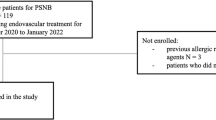Abstract
Purpose
To demonstrate feasibility and safety of ultrasound-guided popliteal sciatic nerve block for providing analgesia during urgent endovascular treatment of critical limb ischemia with resting pain.
Materials and Methods
Ultrasound-guided popliteal sciatic blocks were performed by an interventional radiologist in angiography suite immediately prior to commencement of urgent endovascular treatment of 30 critical limb ischemia patients. Subjective pain levels prior to and following sciatic block were assessed using the visual analog scale (VAS). Need for any supplemental anxiolytics or analgesics during treatment was recorded. Post-procedural evaluation of patient and operator satisfaction levels regarding the intervention was also documented.
Results
Ultrasound-guided sciatic block provided adequate analgesia in all patients; VAS scores were 0 (no pain) in 87% and 1–3 (mild to annoying pain) in 13%. Two patients required anxiolytic premedication. Additional analgesia was not required during course of endovascular treatment of any patients. Time necessary to perform sciatic block ranged 3–9 (mean 5.9 ± 1.3) min. Median number of needle attempts was 1 (range 1–3). Onset of satisfactory block ranged from 5 to 20 min (mean 9.4 ± 2.6 min). Mean treatment time was 102.2 ± 36.7 min, and balloon time was 22.4 ± 6.1 min. Patient and operator satisfaction with pain control were very good in all cases. There were no procedure-related complications.
Conclusions
Ultrasound-guided popliteal sciatic block is a feasible and safe alternative for providing adequate analgesia during urgent endovascular treatment of critical limb ischemia with resting pain.
Level of Evidence
Level 4, case series.




Similar content being viewed by others
References
Marcus AJ, Lotzof K, Kamath BS, et al. A new approach: regional nerve blockade for angioplasty of the lower limb. Cardiovasc Intervent Radiol. 2006;29:235–40.
Liu SS, Strodtbeck WM, Richman JM, Wu CL. A comparison of regional versus general anesthesia for ambulatory anesthesia: a meta-analysis of randomized controlled trials. Anesth Analg. 2005;101:1634–42.
Kent ML, Hackworth RJ, Riffenburgh RH, et al. A comparison of ultrasound-guided and landmark-based approaches to saphenous nerve blockade: a prospective, controlled, blinded, crossover trial. Anesth Analg. 2013;117:265–70.
McCartney CJ, Lin L, Shastri U. Evidence basis for the use of ultrasound for upper-extremity blocks. Reg Anesth Pain Med. 2010;35:S10–5.
Neal JM, Mulroy MF, Weinberg GL. American society of regional anesthesia and pain medicine checklist for managing local anesthetic systemic toxicity: 2012 version. Reg Anesth Pain Med. 2012;37:16–8.
Moran TC, Kaye AD, Mai AH, Bok LR. Sedation, analgesia, and local anesthesia: a review for general and interventional radiologists. Radiographics. 2013;33:E47–60.
Neal JM. Ultrasound-guided regional anesthesia and patient safety: update of an evidence-based analysis. Reg Anesth Pain Med. 2016;41:195–204.
Sermeus L, Pirson A, Breebaart B, et al. Clinical guidelines for the practice of peripheral nerve blocks in the adult. Acta Anaesthesiol Belg. 2013;64:105–8.
Lehman MA, Lind LJ. Sedation, analgesia, and anesthesia. In: Kandarpa K, Machan L, Durham J, editors. Handbook of interventional radiologic procedures. Philadelphia: Wolters Kluwer; 2016. p. 590–600.
Perlas A, Brull R, Chan VW, McCartney CJ, Nuica A, Abbas S. Ultrasound guidance improves the success of sciatic nerve block at the popliteal fossa. Reg Anesth Pain Med. 2008;33:259–65.
Mariano ER, Loland VJ, Sandhu NS, et al. Comparative efficacy of ultrasound-guided and stimulating popliteal-sciatic perineural catheters for postoperative analgesia. Can J Anaesth. 2010;57:919–26.
Dufour E, Quennesson P, Van Robais AL, et al. Combined ultrasound and neurostimulation guidance for popliteal sciatic nerve block: a prospective, randomized comparison with neurostimulation alone. Anesth Analg. 2008;106:1553–8.
Danelli G, Fanelli A, Ghisi D, et al. Ultrasound vs nerve stimulation multiple injection technique for posterior popliteal sciatic nerve block. Anaesthesia. 2009;64:638–42.
Bendtsen TF, Nielsen TD, Rohde CV, Kibak K, Linde F. Ultrasound guidance improves a continuous popliteal sciatic nerve block when compared with nerve stimulation. Reg Anesth Pain Med. 2011;36:181–4.
Bang SU, Kim DJ, Bae JH, Chung K, Kim Y. Minimum effective local anesthetic volume for surgical anesthesia by subparaneural, ultrasound-guided popliteal sciatic nerve block: a prospective dose-finding study. Medicine. 2016;95:e4652.
Latzke D, Marhofer P, Zeitlinger M, et al. Minimal local anaesthetic volumes for sciatic nerve block: evaluation of ED 99 in volunteers. Br J Anaesth. 2010;104:239–44.
Keplinger M, Marhofer P, Marhofer D, et al. Effective local anaesthetic volumes for sciatic nerve blockade: a clinical evaluation of the ED99. Anaesthesia. 2015;70:585–90.
Jamieson S. Likert scales: how to (ab)use them. Med Educ. 2004;38:1217–8.
Author information
Authors and Affiliations
Corresponding author
Ethics declarations
Conflict of interest
All authors declare that they have no conflicts of interest.
Animal and Human Rights Statement
All procedures performed in studies involving human participants were in accordance with the ethical standards of the institutional and/or national research committee and with the 1964 Declaration of Helsinki and its later amendments or comparable ethical standards.
Informed Consent
Informed consent was obtained from all individual participants included in the study.
Rights and permissions
About this article
Cite this article
Tureli, D., Deniz, S., Unlukaplan, A. et al. Ultrasound-Guided Popliteal Sciatic Block Provides Adequate Analgesia During Urgent Endovascular Treatment of Critical Limb Ischemia with Resting Pain. Cardiovasc Intervent Radiol 41, 43–48 (2018). https://doi.org/10.1007/s00270-017-1802-2
Received:
Accepted:
Published:
Issue Date:
DOI: https://doi.org/10.1007/s00270-017-1802-2




